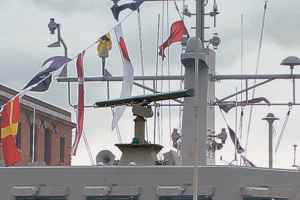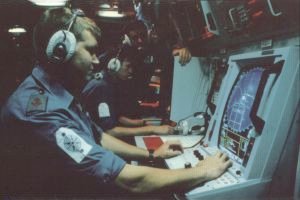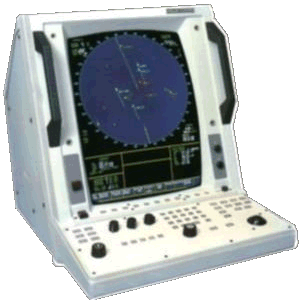Type 1007 Naval/coastal surveillance and navigation radar
Description of the radar set, tactical-technical characteristics

Figure 1: Antenna of Type 1007 Naval/coastal surveillance and navigation radar
| Specifications | |
|---|---|
| frequency: | 9 410 MHz |
| pulse repetition time (PRT): | |
| pulse repetition frequency (PRF): | |
| pulsewidth (τ): | |
| receive time: | |
| dead time: | |
| peak power: | 25 kW |
| average power: | |
| instrumented range: | 300 km |
| range resolution: | |
| accuracy: | |
| beamwidth: | 0.75° |
| hits per scan: | |
| antenna rotation: | |
| MTBCF: | |
| MTTR: | |
Type 1007 Naval/coastal surveillance and navigation radar
The Kelvin Hughes Type 1007 family of naval radars are high-definition surface warning and navigational radar systems in service with the U.K. Royal Navy and several other world navies. The radars are available in I-band and F-band versions. It consists of a range of navigation, surface and air search equipment for naval use. It includes a choice of antennas, I-band and F-band transmitter/receivers and a range of displays. Reduced magnetic signature variants are available for use on mine countermeasures vessels.
The transmitter/receivers are solid-state, with the exception of the magnetron, and operate at frequencies of 9,410 and 3,050 MHz ( I- and F-Band) with a transmitter power output of 25 kW. A wide dynamic range logarithmic receiver is provided. A built-in monitoring system is included to check that the equipment is operating at peak performance. A low leakage dummy load allows for system testing during periods of radar silence. Centralised emission control circuitry enables command to inhibit transmission immediately. Sector transmission is also incorporated with direct control from the CTD main display (optional for the F-band radar). Blanking pulses are incorporated to safeguard sensitive electronic support measures equipment.
Features include:
- High Definition, full colour rasterscan display (1360 x 1024 pixels)
- Flexible design - wide application for ship and land based systems
- Automatic tracking of up to 50 targets plus manual tracking of 20 targets
- Navigation lines/parallel index lines
- Comprehensive mapping with internal 200 map memory plus unlimited external maps
- Alpha numeric labelling of tracks and maps
- Ability to draw sector screens
- 16 auto-acquisition or exclusion zones
- Ability to target indicate to weapon systems
- Helicopter landing path graphics
- Compatible with RPB and VESTA transponder systems and IFF
- Command aids-blind arcs, weapon pointing line, time and range to go for engagement
- Sector transmission control
- Digital input-output ports for sending receiving and displaying system data
- Can display up to 4 different radars
- All maps/nav lines scaled to range in use
- Minimal training required to become a proficient operator
- Operator error prompts
- Simulation mode allows training at sea or in harbour
- Automatic system status fail warning
- Build-in test facilities
The Colour Tactical Display (CTD) is a highly capable navigation display with a wide selection of operational/tactical facilities. It has a built-in tracking capability of up to 50 Automatically tracked targets and 20 Manually tracked targets. The Kelvin Hughes CTD is radar diaplay of the Type 1007 high definition surface warning and navigational radar system, available in both I- and F-Band versions.
Design - proved in many thousands of hours of operation at sea, the designs have been refined and scrupulously tailored to meet the special demands of the modern warship. Many extra facilities, which are needed for naval use, are included as standard.
The CTD Has been the 'Work Horse' for The Irish Navy for the past seven years. CTD's are fitted on all of the Irish Navy's fleet.
The CTD gives the operator a clear sharp colour tactical picture out to over 300 km with the ability to label tracks with ship's names/numbers. Symbology and a choice of colours are used to indicate hostile/friendly/neutral/unkown, and whether air/surface or subsurface.
Standard interfacing includes most log, gyro and Global Postioning System equipment. The CTD can receive four radar video inputs and three auxiliary video inputs. Optional facilities include the control and display of frequency modulated continuous wave radars, ability to receive plot extracted data, VESTA, carry out IFF active gate interrogation, and interfacing to most combat systems, fire-control systems, infrared and electronic support measures equipments. A high-speed air tracking facility is available as an option.
The CTD displays can be networked to share track data and form a highly cost-effective command system. A weatherproof auxiliary raster scan display is available as an option. This unit is portable and is designed for use on an open bridge or a submarine fin. A built-in simulator package allows onboard training to be carried out in the minimum of time.

Figure 2: CTD in use

Figure 3: Kelvin Hughes CTD
Source: homepage.eircom.net
more: Jane's Radar and Electronic Warfare Systems.
